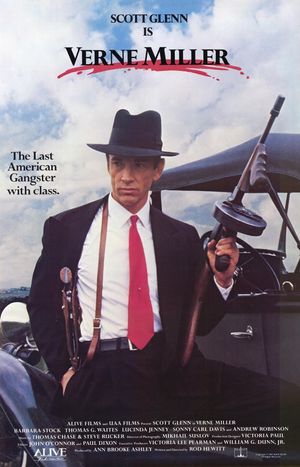The Verne Miller Story: Difference between revisions
(More specific category) |
No edit summary |
||
| Line 6: | Line 6: | ||
The producers convinced organizers of a Halloween Bash at [[University Inn]] on [[October 31]], [[1986]] to advertise a 1930s theme for their costume contest as a means of casting extras. | The producers convinced organizers of a Halloween Bash at [[University Inn]] on [[October 31]], [[1986]] to advertise a 1930s theme for their costume contest as a means of casting extras. | ||
Filming locations in Alabama included the [[Alabama Theatre]], the [[Tutwiler Hotel (1986)|Tutwiler Hotel]], downtown [[Springville]], the [[Woodward House]] on [[Red Mountain]], [[Romeo's]] on [[7th Avenue South]], the [[Bessemer Hall of History]], and the pedestrian tunnel under [[Independence Drive]] between [[Shades Cahaba Elementary School]] and [[Piggly-Wiggly]]'s parking lot. | Filming locations in Alabama included the [[Alabama Theatre]], the [[Tutwiler Hotel (1986)|Tutwiler Hotel]], downtown [[Springville]], the [[Woodward House]] on [[Red Mountain]], [[Romeo's]] on [[7th Avenue South]], the [[Bessemer Hall of History]], and the pedestrian tunnel under [[Independence Drive]] between [[Shades Cahaba Elementary School]] and [[Piggly-Wiggly]]'s parking lot. Period automobiles in the film were lent by the [[Moore Auto Classic Museum]]. | ||
After premiering in Birmingham, the film was screened at the Montréal World Film Festival on August 30. It was not released to general audiences in the United States until [[June 21]], [[1988]] and was distributed on videocassette by Nelson Entertainment as ''Gangland''. | After premiering in Birmingham, the film was screened at the Montréal World Film Festival on August 30. It was not released to general audiences in the United States until [[June 21]], [[1988]] and was distributed on videocassette by Nelson Entertainment as ''Gangland''. | ||
Revision as of 10:24, 15 August 2016
The Verne Miller Story (later distributed as Gangland) is a 1987 feature film produced by Alive Films. It was written and directed by Rod Hewitt, and starred Scott Glenn as a hit-man for Al Capone's Chicago mob. The sensationalized story was inspired by actual persons and events. Some scenes for the feature were filmed in the Birmingham area, and the completed film had its world premiere at the Alabama Theatre on July 30, 1987.
Birmingham's Carl Spurlock played a judge in the film and Bob Penny portrayed a real estate agent. Bessemer's Henry David DeBardeleben worked on the production as second unit director. Production credits in the film included recognition for the Alabama Film Office, Birmingham Film Council, Alabama Landmarks, Alabama Power Company, the Alabama State Highway Department, UAB, University of Montevallo and University of North Alabama.
The producers convinced organizers of a Halloween Bash at University Inn on October 31, 1986 to advertise a 1930s theme for their costume contest as a means of casting extras.
Filming locations in Alabama included the Alabama Theatre, the Tutwiler Hotel, downtown Springville, the Woodward House on Red Mountain, Romeo's on 7th Avenue South, the Bessemer Hall of History, and the pedestrian tunnel under Independence Drive between Shades Cahaba Elementary School and Piggly-Wiggly's parking lot. Period automobiles in the film were lent by the Moore Auto Classic Museum.
After premiering in Birmingham, the film was screened at the Montréal World Film Festival on August 30. It was not released to general audiences in the United States until June 21, 1988 and was distributed on videocassette by Nelson Entertainment as Gangland.
External links
- The Verne Miller Story at IMDB.com
